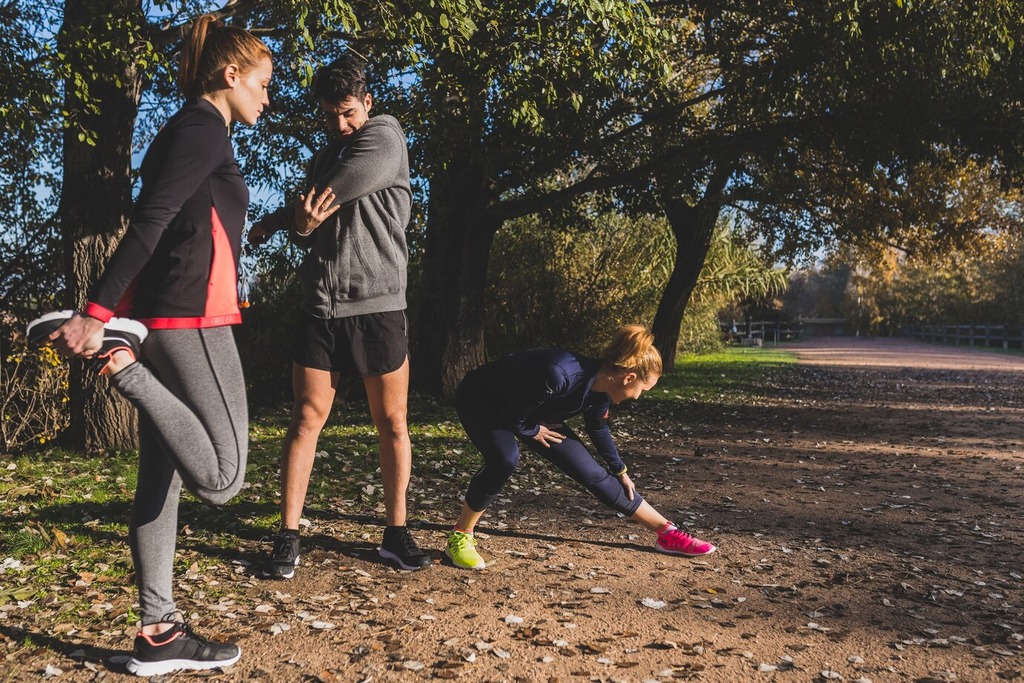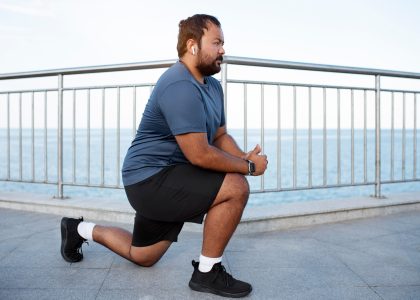Are you ready to lace up your boots, hit the trails, and conquer some breathtaking vistas?
Well, hold onto your hats (or should we say, your hiking hats?) because we’re about to talk about some of the expert-recommended hiking exercises.
Whether you’re aiming for a leisurely stroll or a heart-pumping hike, having the right exercises in your backpack can make all the difference.
So, without any delay, let’s get into the nitty-gritty of those exercises with step-by-step guides:
Bodyweight Exercises For Hikers
Let’s take a look at the best bodyweight workouts for hiking:
1. Kneeling Half Stand-Ups
Kneeling half stand-ups help hikers by strengthening their lower body muscles, particularly the quadriceps, hamstrings, and glutes.
These muscles are crucial for powering uphill climbs and providing stability on uneven terrain.
This hiking exercise improves leg strength and endurance by mimicking the motion of standing up from a kneeling position. It enables hikers to tackle steep inclines with greater ease and efficiency.
Step-By-Step Guide:
- Start by kneeling on the ground with your knees hip-width apart.
- Keep your torso upright and engage your core.
- Step one foot forward, placing it flat on the ground so that your knee is directly above your ankle.
- Push through the heel of your front foot to stand up halfway, keeping your back straight.
- Slowly lower back down to the kneeling position.
- Repeat on the other side, alternating legs for each repetition.
2. Leopard Crawl
Leopard crawl is a full-body exercise for hiking that builds core strength, coordination, and agility.
By moving in a low, crawling position, hikers engage their core muscles, stabilizing their spine and improving balance on rocky or uneven terrain.
The crawling motion also strengthens the shoulders, arms, and legs, enhancing overall endurance and resilience during long hikes.
Step-By-Step Guide:
- Start on your hands and knees with your wrists directly under your shoulders and your knees under your hips.
- Lift your knees a few inches off the ground, keeping your back flat and your core engaged.
- Crawl forward by moving your opposite hand and foot simultaneously, keeping your movements smooth and controlled.
- Keep your hips level and avoid rocking from side to side.
- Crawl for a set distance or time, then reverse the movement to crawl backward.
3. Downward Facing Dog to High Plank
This dynamic yoga sequence targets multiple muscle groups, including the core, arms, shoulders, and legs, making it ideal for hikers seeking a comprehensive workout.
Downward facing dog stretches the calves and hamstrings while strengthening the upper body, promoting flexibility and mobility essential for navigating varied terrain.
Transitioning to high plank strengthens the core and improves posture, reducing the risk of back pain and injury during extended hikes.
Step-By-Step Guide:
- Begin in a plank position with your hands shoulder-width apart and your wrists aligned under your shoulders.
- Lift your hips up and back into a downward facing dog position, forming an inverted V shape with your body.
- Press your heels toward the ground and lengthen through your spine, keeping your head between your arms.
- Shift forward into a high plank position, keeping your core engaged and your body in a straight line from head to heels.
- Hold the plank briefly, then reverse the movement to return to downward facing dog.
- Repeat the sequence, moving smoothly between the two positions.
4. Side Plank with Rotation
Side plank with rotation primarily targets the oblique muscles, which play a crucial role in stabilizing the torso and maintaining proper alignment during hiking.
By adding a rotational component to the traditional side plank, this exercise engages the entire core, improving balance and coordination on uneven trails.
Strengthening the obliques also enhances spinal stability, reducing the risk of injuries such as twists or strains while carrying a backpack or navigating challenging terrain.
Step-By-Step Guide:
- Start in a side plank position with your elbow directly beneath your shoulder and your body in a straight line from head to heels.
- Lift your top arm toward the ceiling, opening your chest toward the sky.
- Rotate your torso, bringing your top arm underneath your body and toward the ground.
- Return to the starting position, extending your arm back toward the ceiling.
Strength Exercises & Workouts For Hiking
Here are some of the best exercises and workouts for hikers that will result in increased strength and stamina:
5. Step Aerobics
Step aerobics is an excellent cardiovascular workout that enhances hikers’ endurance and stamina.
By engaging in rhythmic stepping movements, hikers improve their heart and lung function, allowing them to sustain physical activity for longer periods without fatigue.
Additionally, step aerobics targets the muscles of the lower body, including the calves, quadriceps, and glutes, which are essential for maintaining a steady pace and navigating challenging trails.
Step-By-Step Guide:
- Find a sturdy step platform or use a staircase.
- Stand facing the step with your feet hip-width apart.
- Step onto the platform with one foot, followed by the other.
- Step back down one foot at a time, returning to the starting position.
- Repeat, alternating which foot leads the movement.
- Maintain a steady pace and engage your core for stability.
6. Downhill Lunges
Downhill lunges specifically target the quadriceps, glutes, and calves, which are essential for controlling descent and absorbing impact while hiking downhill.
By strengthening these muscles, hikers can maintain stability and control during steep descents, reducing strain on the knees and preventing muscle fatigue.
Downhill lunges also improve balance and proprioception, enhancing overall confidence and agility on rugged trails.
Step-By-Step Guide:
- Stand tall with your feet hip-width apart and your hands on your hips.
- Step backward with one foot, lowering your back knee toward the ground into a lunge position.
- Keep your front knee aligned with your ankle and your back knee hovering just above the ground.
- Push through your front heel to return to the starting position.
- Repeat on the other side, alternating legs for each repetition.
- Focus on maintaining proper form and control throughout the movement.
7. Hanging Knee Raises
Hanging knee raises primarily target the lower abdominal muscles, which are often neglected in traditional core workouts but are essential for maintaining stability and balance while hiking.
By lifting the knees toward the chest, hikers strengthen the hip flexors and lower abs, improving pelvic stability and reducing the risk of lower back pain during long treks.
Additionally, hanging knee raises engage the upper body, particularly the grip and shoulder muscles, contributing to overall strength and endurance on challenging terrain.
Step-By-Step Guide:
- Hang from a pull-up bar with an overhand grip, allowing your body to extend fully.
- Engage your core and lift your knees toward your chest, bending at the hips.
- Pause briefly at the top of the movement, squeezing your abs.
- Lower your knees back down with control, returning to the starting position.
8. Bridge with Hamstring Curl
Bridge with hamstring curl is a compound exercise for hikers that targets the glutes, hamstrings, and lower back muscles, promoting better posture and spinal alignment during hiking.
By lifting the hips off the ground and performing a hamstring curl, hikers strengthen the posterior chain, which is essential for power generation and propulsion while walking uphill.
This exercise also improves hip mobility and flexibility, reducing the risk of hip and lower back injuries during prolonged hiking trips.
Step-By-Step Guide:
- Lie on your back with your knees bent and your feet flat on the ground, hip-width apart.
- Lift your hips toward the ceiling, engaging your glutes and core to form a straight line from your shoulders to your knees.
- Keeping your hips lifted, extend one leg out straight, lifting it off the ground.
- Bend your knee and draw it back in toward your body, curling your heel toward your glutes.
- Extend your leg back out straight, then lower your hips back down to the ground.
- Repeat on the other side, alternating legs for each repetition.
- Focus on maintaining stability in your hips and pelvis throughout the movement.
Winding Up
We hope these exercises have inspired you to lace up your boots and hit the trails with confidence.
So, what are you waiting for?
Grab your gear, gather your hiking buddies, and let’s make some memories out on those trails.




